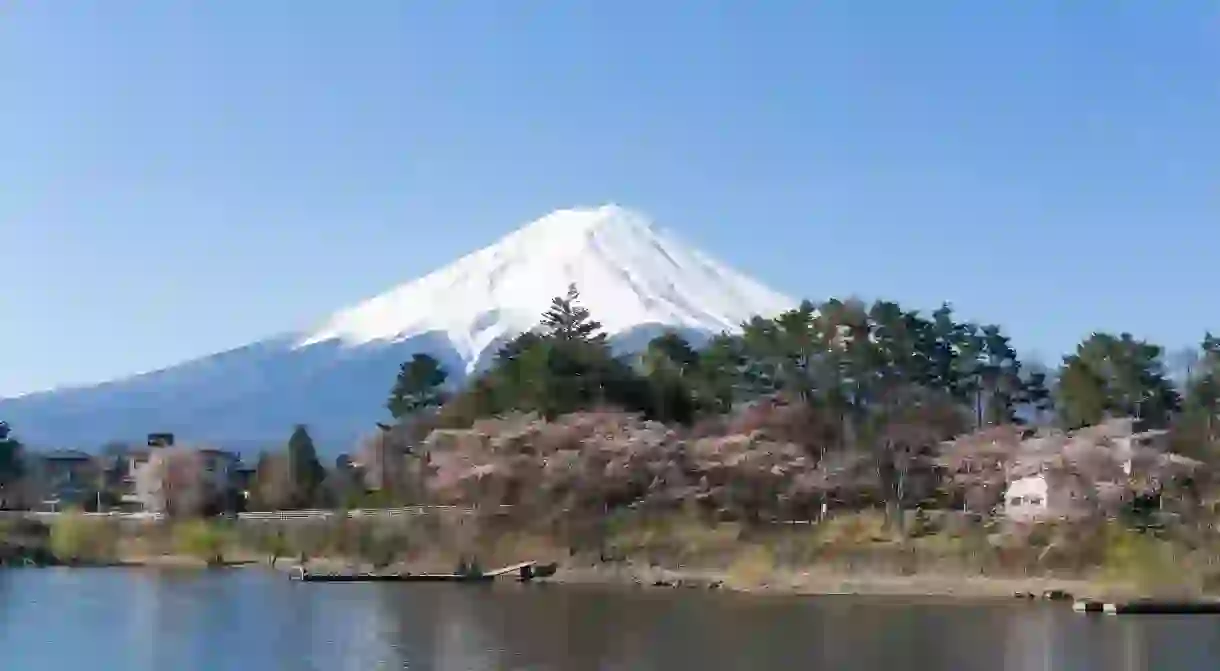The Best Things To Do in Fuji Five Lakes

Japan’s Fuji Five Lakes is an area of rugged mountains, subterranean caves, ancient forest and pristine lakes. Best known as the home of Mount Fuji, there’s far more to do here than simply admire the iconic peak. Check out Culture Trip’s top eight recommendations to get the most from your visit.
Fuji Five Lakes sits up at the northern base of Mount Fuji, and as you might expect, is a hilly region centred around five tranquil lakes: Kawaguchiko, Saiko, Yamanakako, Shojiko and Motosuko. Thanks to its stunning and varied natural beauty, many of the activities in the area are outdoorsy. From exploring lofty mountaintops and hidden lava caves to picturesque ancient shrines and primeval forest, it offers a fantastic chance to see a more rural side of Japan. There are also plenty of indoor activities you can enjoy too, including a wealth of museums and one of Japan’s best theme parks.
One thing this list won’t cover is actually climbing Fuji. It’s definitely one of the best things to do in the region, and because there’s so much to cover we’ve got a whole separate article dedicated to helping you make the summit. In the meantime, here are our suggestions for other must-do activities in Fuji Five Lakes:
Gaze down on the lakes from Mount Fuji's 5th Station
Train Station

If you don’t fancy climbing Fuji, or you’re visiting outside of climbing season, you can still get a close-up look at the peak by travelling up to the Fuji Subaru Line 5th station. This is an observation point about halfway up the Yoshida climbing trail, and is where the majority of climbers begin their hike. The spot offers panoramic views back down over the Fuji Five Lakes region, and you’ll also find a handful of casual restaurants and shops selling a range of Fuji-themed souvenirs. Hourly buses run directly from Kawaguchiko station, making it easy to access, although the road may close during periods of heavy snowfall. A return trip costs 2300 yen.
Head to ancient Japan at Fujiyoshida Sengen Shrine
Shinto Shrine

Before the 5th station was constructed, those who wanted to hike Mount Fuji from the north would begin at the Fujiyoshida Sengen shrine. Free to enter, it stands at the end of a long gravel path lined with moss-covered stone lanterns, hidden among towering cedar trees. A striking, deep red torii gate soaring 18 metres into the air welcomes you, behind which you’ll find the shrine’s main hall. This was built in 1615 and is adorned with two large, imposing wooden masks that watch over worshippers. Right at the back of the grounds stands the simple wooden torii gate that makes the start of Fuji’s Yoshida trail.
Ride the Panoramic Ropeway up colourful Mount Tenjo
Natural Feature

To enjoy some of the best views of Fuji, hop on the Mount Fuji Panoramic Ropeway that runs up to the top of Mount Tenjo (or hike up to save some yen!). This 1,104-metre peak stands on the eastern shores of Lake Kawaguchi, and is the setting for a rather interesting Japanese folk tale about a mischievous tanuki (racoon) and the rabbit that gets revenge on him. Colourful statues of the characters can be found dotted around the mountainside and there’s also a rabbit shrine near the summit. If you’re visiting with your partner, don’t miss the Bell of Tenjo. It sits in a heart-shaped frame, and is said to grant couples a long and happy relationship if they ring the bell together while looking at Fuji.
Hike to the summit of Mount Mitsutoge for epic views of Fuji
Hill Station, Natural Feature

Fuji is far from the only mountain in the region that’s worth summiting. Keen hikers can continue north-east from the top of Mount Tenjo and go on to tackle the 1,785-metre Mount Mitsutoge. As well as being arguably the best place from which to view Mount Fuji’s dramatic peak, on a clear day you can see all the way to Tokyo and Japan’s Southern Alps. The entire trek takes around six hours, leading you along earthy trails that run through the forest, so bring plenty of food and water. The hike is best enjoyed in spring or autumn, when the weather conditions are most pleasant.
Soak up the culture at the lakes' many museums
Building, Museum
Explore the depths of subterranean lava caves
Forest, Natural Feature
Fuji’s influence on the local landscape isn’t limited to above ground. The volcano’s past eruptions and subsequent lava flows have created a number of caves around Lake Sai. Three of these are open to the public to explore: the Bat, Ice and Wind caves. With your rented hard hat on, you can navigate through the narrow tunnels and chilly, low-ceilinged chambers – many of which are lined with ice year-round. Get a combination ticket to save on entry, and take the pleasant walking trail that links them through the thick foliage of Aokigahara forest. Although the deeper parts of the ‘sea of trees’ have a slightly macabre reputation as a suicide spot, this section is well-travelled and beautiful.
Get your adrenaline pumping at Fuji-Q Highland
Amusement Park
Capture the quintessential image of Japan at Chureito Pagoda
Natural Feature

The image of Mount Fuji’s perfectly conical snow-capped peak is one that every visitor to Fuji Five Lakes wants to capture. There are plenty of viewing spots where you can get a great photo, however if you really want a sight worth preserving, head to the Chureito pagoda at Arakura Sengen shrine. A gorgeous vision in red and white, this five-storied pagoda sits on a hillside at the top of 400 stone steps. From the observation point, you can see Mount Fuji in the distance with the top winged tiers of the pagoda in the foreground. When combined with the blossoming of the cherry blossoms in spring, it’s one of the most classic shots of Japan you can get.













